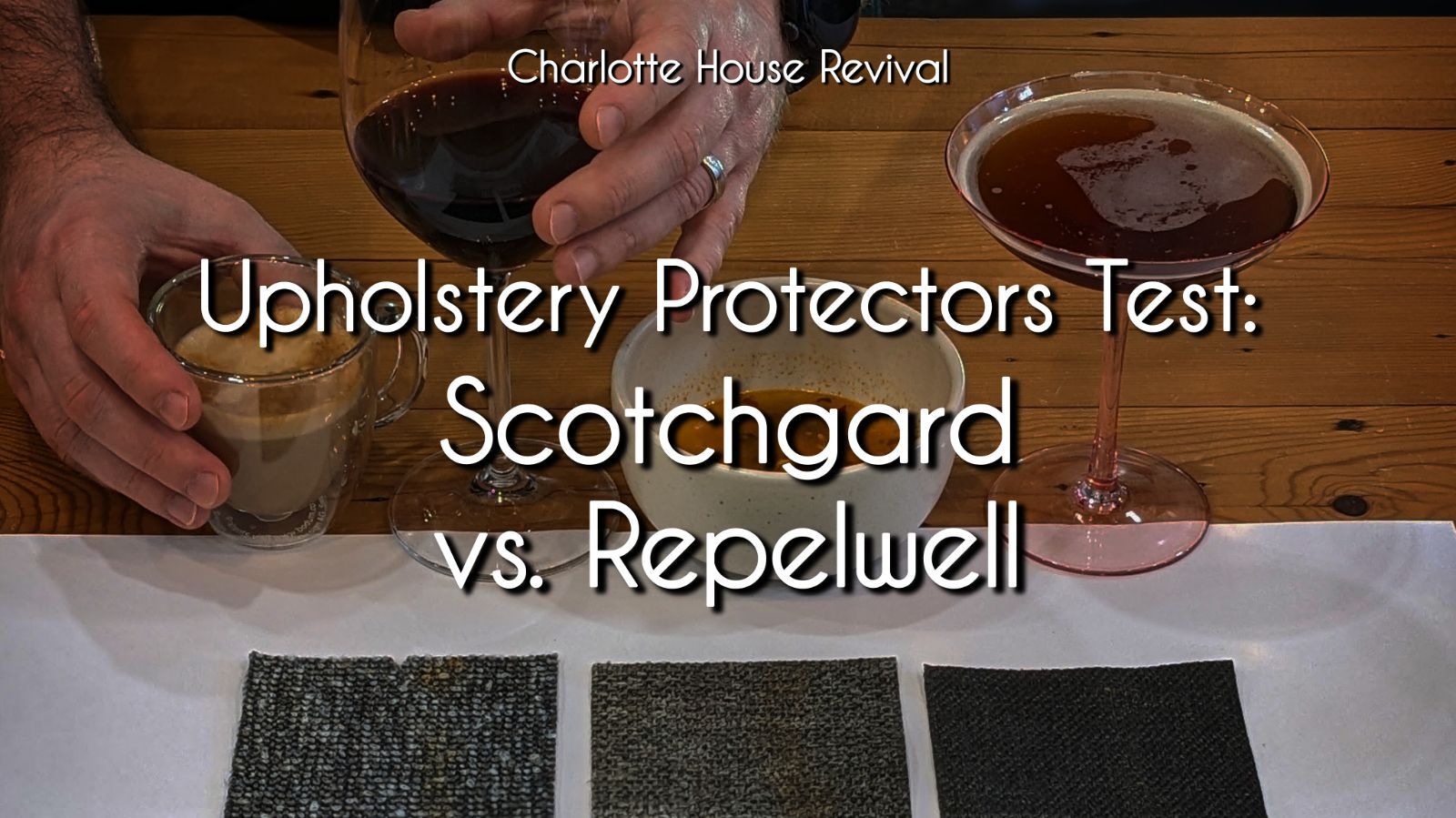Upholstery Spray Challenge: Which Works Best, Scotchgard or RepelWell?
We’re giving you the comparison between Scotchgard and RepelWell you didn’t know you needed to find out which upholstery spray works best to repel common households stains from sofas & furniture.
Our new Room & Board living room furniture will be here soon, but we would be remiss not to share with you this educational-ish video we took a few weeks back.
Before we decided on our furniture, I pulled out all the stops to make sure we won’t get buyer’s remorse. I had been jonesing for a light-colored sofa, but if there’s one thing I know about myself, it’s that I don’t want to feel stressed out if the kids have messy hands, or if I’m sitting on the couch with my morning coffee when a small child decides to tackle me.
To avoid upholstery headaches, Jim and I conducted an upholstery test with sample swatches from Room & Board to take a look at how well Scotchgard and Repelwell hold up to coffee, cocktails, food, and red wine – some of the most common stains you’d encounter at Charlotte House!
Scotchgard is the most common name in the upholstery spray game, known for effectiveness & durability. Though it works well, it’s not without some concerns, as Scotchgard also contains chemicals that many would prefer to avoid.
On the other hand, RepelWell is an alternative that’s well worth considering. It’s water-based silicone spray is more eco-friendly, kid-friendly, and pet-friendly, but it does need to be sprayed every few months, depending on wear & use.
Necessary(-ish) Things Featured in this Video:
Affiliate links for all the things we used in this video that might be helpful, because messy cocktails can happen to even the best of us
The O.G. upholstery spray, this will definitely get the job done, albeit with some chemicals
Water-based silicone fabric protector that’s safer for kids, pets, & the environment
Because I like a coupe better than a martini glass, mmkay?
Which is Better?: Scotchgard vs Repelwell
You can watch the full video of our Scotchgard vs Repelwell test in the video above to see just how each fabric spray protected our upholsteries, but in a nutshell, here’s what we found:
Look for Quick and Long-Lasting Liquid “Beading”
We learned that on well-protected fabrics, liquid spills should bead up quickly rather than soak directly into the fabrics. The better the protection, the longer the liquid will sit in “bead” form, giving you more time to grab a rag or brush off the spill.
Eventually, all the liquid “beads” did break down and soak into the fabric; some just took longer than others. With that in mind, it’s probably still best to keep an absorbent rag nearby if you’re hoping to protect lighter fabrics from spills. In case of spillage, your fabric protector will buy you more time to remove the liquid, but no upholstery spray will make your furniture impenetrable.
Even “Performance” Fabrics Can be Improved with Upholstery Spray
Some of the upholsteries we tested were “performance” fabrics meant for kids and high traffic. They had slightly better spill resistance, but every single sample fared much better with an upholstery protector spray.
As a parent or pet owner, it might seem like we have to restrict our choices to Performance Only fabrics. But our test showed that Upholstery Protector Sprays like Scotchgard and Repelwell made huge improvements to all our samples. With the right protection, I think that opens up way more possibilities when it comes to fabric choices.
More Texture = More Product
Our test showed that highly texture fabrics, like bouclés and certain knits, tended to absorb any liquid “bead” spills faster than smoother fabrics.
All our upholstery samples were treated with two coats of either Scotchgard or Repelwell, which seemed to be enough for the smooth fabrics. But the samples with more texture had far more “nooks and crannies” that were not fully protected from only two coats. This left weak spots for the liquids to penetrate our fabrics and be absorbed.
With that in mind, we can strongly recommend using additional coats of upholstery protector spray on any furniture or rugs that are highly textured. Keep in mind: you’ll want to go with additional coats, not heavier coats, to get the furniture protection you’re looking for.
Pros & Cons: Scotchgard vs Repelwell
Both Scotchgard and Repelwell gave our upholsteries significantly better protection from our test liquids. Let’s take a look at what we learned about both options.
Scotchgard Pros & Cons
• Easier to spray
• Requires less frequent re-applications
• Contains more harmful chemicals
Repellwell Pros & Cons
• High performance without harmful chemicals and additives
• Safer for kids, pets, and the environment
• Requires manual spraying, which can be cumbersome when spraying large rugs or furniture
• May require more frequent re-applications depending on wear
The Verdict: Scotchgard vs Repelwell
Our test showed that both upholstery protector sprays were comparable in terms of actual fabric protection. On several of our samples, the fabric protection was exactly the same; on others, we found that Repelwell performed just slightly better than Scotchgard.
For our purposes, we decided that REPELWELL was the better option for our fabric protector needs.
Though we may need to reapply slightly more often, we feel much safer about our kids using furniture that’s been coated with a non-chemical fabric protector spray, especially when we found that spray to be so effective at repelling stains!
>> UPDATE: Want to See Which Upholstery We Chose? <<
(We even used furniture protector spray on the rug!)
Tell us what you think, if you have a favorite, and which one you think you’ll try next on your newest (or oldest?) sofa or furniture.










1 COMMENT